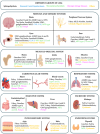Extracellular Vesicles as Tools for Crossing the Blood-Brain Barrier to Treat Lysosomal Storage Diseases
- PMID: 39860010
- PMCID: PMC11766495
- DOI: 10.3390/life15010070
Extracellular Vesicles as Tools for Crossing the Blood-Brain Barrier to Treat Lysosomal Storage Diseases
Abstract
Extracellular vesicles (EVs) are nanosized, membrane-bound structures that have emerged as promising tools for drug delivery, especially in the treatment of lysosomal storage disorders (LSDs) with central nervous system (CNS) involvement. This review highlights the unique properties of EVs, such as their biocompatibility, capacity to cross the blood-brain barrier (BBB), and potential for therapeutic cargo loading, including that of enzymes and genetic material. Current therapies for LSDs, like enzyme replacement therapy (ERT), often fail to address neurological symptoms due to their inability to cross the BBB. EVs offer a viable alternative, allowing for targeted delivery to the CNS and improving therapeutic outcomes. We discuss recent advancements in the engineering and modification of EVs to enhance targeting, circulation time and cargo stability, and provide a detailed overview of their application in LSDs, such as Gaucher and Fabry diseases, and Sanfilippo syndrome. Despite their potential, challenges remain in scaling production, ensuring isolation purity, and meeting regulatory requirements. Future developments will focus on overcoming these barriers, paving the way for the clinical translation of EV-based therapies in LSDs and other CNS disorders.
Keywords: blood–brain barrier; drug delivery; enzyme replacement therapy; exosomes; extracellular vesicles; lysosomal storage diseases; neurodegenerative diseases; protein delivery.
Conflict of interest statement
I.A. is the inventor of patent WO/2014/001509 and patent application PCT/EP2022/051727 that are not related to EVs but have application in LSDs. G.P.-M. received honoraria, for consulting, and/or travel support, for scientific meetings, from Chiesi, Takeda, and Immedica. M.d.T. received honoraria for, consulting, and/or travel support, for scientific meetings, from Chiesi, Takeda, Ultragenyx, Sanofi, and Alexion. All other authors declare that they have no competing interests.
Figures




References
-
- Théry C., Witwer K.W., Aikawa E., Alcaraz M.J., Anderson J.D., Andriantsitohaina R., Antoniou A., Arab T., Archer F., Atkin-Smith G.K., et al. Minimal Information for Studies of Extracellular Vesicles 2018 (MISEV2018): A Position Statement of the International Society for Extracellular Vesicles and Update of the MISEV2014 Guidelines. J. Extracell. Vesicles. 2018;7:1535750. doi: 10.1080/20013078.2018.1535750. - DOI - PMC - PubMed
-
- Albrecht M., Hummitzsch L., Rusch R., Heß K., Steinfath M., Cremer J., Lichte F., Fändrich F., Berndt R., Zitta K. Characterization of Large Extracellular Vesicles (L-EV) Derived from Human Regulatory Macrophages (Mreg): Novel Mediators in Wound Healing and Angiogenesis? J. Transl. Med. 2023;21:61. doi: 10.1186/s12967-023-03900-6. - DOI - PMC - PubMed
Publication types
Grants and funding
LinkOut - more resources
Full Text Sources

